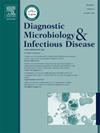西尼罗河病毒在以色列爆发的特点和临床结果2024:一项回顾性队列研究
IF 2.1
4区 医学
Q3 INFECTIOUS DISEASES
Diagnostic microbiology and infectious disease
Pub Date : 2025-05-31
DOI:10.1016/j.diagmicrobio.2025.116936
引用次数: 0
摘要
2024年,以色列经历了20年来最大的西尼罗河病毒(WNV)爆发,有930多例病例和72例死亡,揭示了独特的流行病学模式。目的描述本次疫情期间西尼罗河病毒感染患者住院预后不良的临床特征、结局和危险因素。方法对Rabin医疗中心(RMC) 2024年收治的西尼罗河病毒感染患者进行回顾性队列研究。对电子病历数据进行分析。采用回归模型确定与不良预后相关的危险因素。结果纳入177例患者。他们的中位年龄为77岁,其中72例(41%)为女性。常见的有发热(82%)、精神状态改变(62%)、不适(62%)、血小板减少(44%)、急性肾衰竭(38%)和淋巴细胞减少(36%)。89例(50%)患者被诊断为西尼罗河神经侵袭性疾病(WNND),主要是脑炎(41%)。中位住院时间为7天,22例(12%)院内死亡。死亡的危险因素包括卒中史、WNND、急性肾功能衰竭和淋巴细胞减少。在幸存者中,45人(29%)出院接受康复或长期护理设施。结论这些发现突出了暴发期间西尼罗河病毒感染的临床严重程度,并强调了识别高危患者对指导管理和公共卫生策略的重要性。本文章由计算机程序翻译,如有差异,请以英文原文为准。
Characteristics and clinical outcomes of the West Nile virus outbreak in Israel 2024: A retrospective cohort study
Background
In 2024, Israel experienced its largest West Nile virus (WNV) outbreak in two decades, with over 930 cases and 72 deaths, revealing unique epidemiological patterns.
Aim
To describe the clinical features, outcomes, and risk factors for poor hospitalization outcomes in patients with WNV infection during this outbreak.
Methods
A retrospective cohort study of WNV-infected patients admitted to Rabin Medical Center (RMC) during the year 2024. Data from electronic medical records were analyzed. A regression model was employed to identify risk factors associated with poor outcomes.
Results
We included 177 patients. Their median age was 77 years, and 72 (41 %) were female. Fever (82 %), altered mentation (62 %), malaise (62 %), thrombocytopenia (44 %), acute renal failure (38 %), and lymphopenia (36 %) were common. West Nile neuroinvasive disease (WNND), primarily encephalitis (41 %), was diagnosed in 89 (50 %) patients. The median hospital stay was 7 days, with 22 (12 %) in-hospital deaths. Risk factors for mortality included a history of stroke, WNND, acute renal failure, and lymphopenia. Among survivors, 45 (29 %) were discharged for rehabilitation or long-term care facilities.
Conclusions
These findings highlight the clinical severity of WNV infections during the outbreak and underscore the importance of identifying high-risk patients to guide management and public health strategies.
求助全文
通过发布文献求助,成功后即可免费获取论文全文。
去求助
来源期刊
CiteScore
5.30
自引率
3.40%
发文量
149
审稿时长
56 days
期刊介绍:
Diagnostic Microbiology and Infectious Disease keeps you informed of the latest developments in clinical microbiology and the diagnosis and treatment of infectious diseases. Packed with rigorously peer-reviewed articles and studies in bacteriology, immunology, immunoserology, infectious diseases, mycology, parasitology, and virology, the journal examines new procedures, unusual cases, controversial issues, and important new literature. Diagnostic Microbiology and Infectious Disease distinguished independent editorial board, consisting of experts from many medical specialties, ensures you extensive and authoritative coverage.

 求助内容:
求助内容: 应助结果提醒方式:
应助结果提醒方式:


